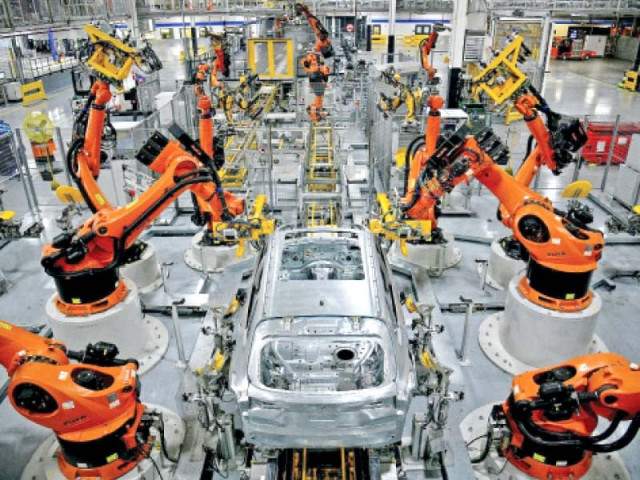LSM growth slows down further
Output of big industries expands just 3.3% in July-November 2021

The slowdown in growth of big industries has deepened with only 3.3% increase in their output in the first five months (July-November) of current fiscal year.
On the other hand, the recent rebasing of economy also points to a drop in the share of job-intensive industrial sector.
The pace of growth of Large Scale Manufacturing (LSM) sector eased to 3.3% in July-November of fiscal year 2021-22, the Pakistan Bureau of Statistics (PBS) reported on Friday.
In November alone, the LSM sector posted a marginal growth of 0.3% over the same month a year ago, according to the PBS.
The low base effect has so far been driving the growth of large industries as the index had dropped to the low of 86.2 in April 2020 from the peak of 160 before Covid-19 struck Pakistan. The index remained below pre-Covid levels as it stood at 147.2 in November 2021.
Out of 15 major industries, 11 recorded growth in their output while production in the remaining four sectors contracted.
Since large industries contribute heavily to revenue collection and job creation, any change in their growth impacts the government and business sentiment accordingly.
The government on Thursday announced the change in base year of the economy from 2005-06 to 2015-16, which also revealed significant changes in the structure of economy.
The share of industrial sector shrank from nearly 21% to 19.5%, which suggested that people were moving away from the manufacturing activities.
De-industrialisation in the country began in 1988 due to the policies implemented under various programmes of the International Monetary Fund (IMF), said Dr Ashfaque Hasan Khan, member of the government’s Economic Advisory Group.
Read Slowdown in LSM growth persists
He was speaking at the Express News primetime show on economy -The Review.
The signing of the Free Trade Agreement with China in 2005 has also badly damaged Pakistan’s industrial base since local industrialists failed to compete with the second largest economy of the world.
The share of LSM sector, which stood at 11.7% under the old base year, has now shrunk to a mere 9.3%, according to the results announced by the National Accounts Committee (NAC) on Thursday.
A working paper of the National Accounts Committee (NAC) showed that the final Gross Value Added (GVA) of the LSM sector had been estimated at Rs2.84 trillion in new base estimates compared to Rs2.8 trillion in old base estimates at current prices for 2015-16, showing a modest increase of 1.4%.
LSM has remained an important source of economic growth in Pakistan. Owing to the encouraging results of this sector in the previous fiscal year coupled with a low base effect, the government managed to show overall 5.4% economic growth in 2020-21.
However, a constant decline in the share and growth of LSM may cause a lot of problems for the government that is struggling to create new jobs.
The government has targeted 4.8% economic growth in the current fiscal year. However, a recent report of the International Monetary Fund (IMF) projected that Pakistan’s economic growth would stand at 4%, which was a decent rate but nearly half of what was required to create jobs for all new entrants into the market.
LSM data is collected from three different sources. Data collected by the Oil Companies Advisory Committee (OCAC) showed that 11 types of industries registered a growth of 0.3% in the first five months of current fiscal year.
The Ministry of Industries, which monitors 15 industries, reported 2.7% increase in output during the July-November period. Similarly, the provincial bureaus reported just 0.3% growth in output of 11 industries, stated the PBS.
Sectors that posted growth in the first five months of FY22 included textile, which grew less than 1%.
The textile sector enjoys the maximum weight of nearly 21% in the LSM index and any movement in the segment significantly impacts the overall LSM sector growth.
Read more Rebasing of economy pays dividend to govt
The output of food and beverages increased 1.5%, coke and petroleum products 4.7%, pharmaceuticals 1.5% and chemicals 7.5%.
The output of the automobile sector increased 35%. Iron and steel sector saw a growth of 25%. Manufacturing of leather products increased 8.2%, paper and board 8.5%, engineering products 1.5% and wood products 200%.
There was a dip of 6.6% in the output of fertiliser plants as the government struggled to provide gas to urea producers to enable them to operate at full capacity. This denies the Ministry of Industries’ claim that urea output was the highest in the current fiscal year.
The output of non-metallic mineral products decreased about 1%, electronics nearly 11% and rubber products 31% during the five-month period under review.
Published in The Express Tribune, January 22nd, 2022.
Like Business on Facebook, follow @TribuneBiz on Twitter to stay informed and join in the conversation.



















COMMENTS
Comments are moderated and generally will be posted if they are on-topic and not abusive.
For more information, please see our Comments FAQ